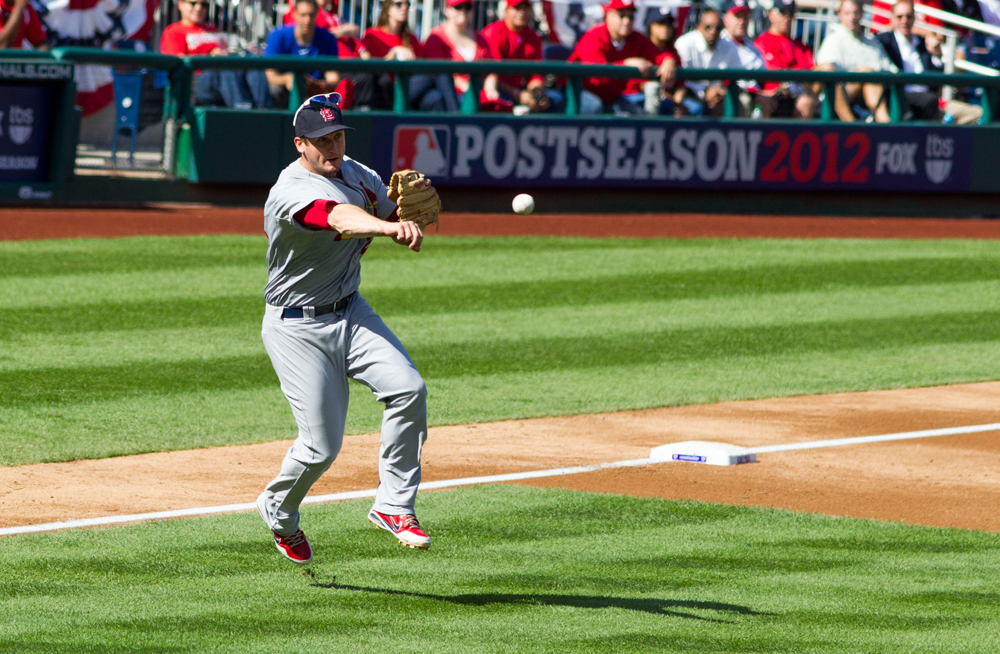
Matt Kemp is hitting .211/.296/.321 in the second half, and he hit even worse than that in August, managing just three extra-base hits in 79 plate appearances. Chris Taylor is hitting .215/.283/.354 in the second half, and has struck out in 36% of his August plate appearances. While several viable internal outfield replacements are coming up in Alex Verdugo and Andrew Toles, both of them are left-handed. Additionally, Dodgers non-pitchers have a precisely league-average line against lefties (.237/.322/.407) compared to a .260/.343/.468 line against right-handed pitching, which leads the league in wRC+. That imbalance was an even issue before accounting for Taylor and Kemp’s struggles. The additional slumps made it an issue which required external options to fix.
Enter David Freese, who the Dodgers acquired moments before the postseason roster eligibility deadline last night. The Dodgers traded Jesus Manuel Valdez to the Pirates, a 20-year-old infielder in the Dominican Summer League. Valdez was not on Dustin’s Top 100 to begin the season, and given his age and level he’s probably not somebody the Dodgers are going to miss. In order to make room for Freese on the 40-man roster, Erik Goeddel was moved to the 60-day disabled list, effectively ending his season. Goeddel was initially sent to the disabled list with “elbow inflammation” in mid-August, so this roster move contains the bad news that he’s probably done. The bullpen could have used his help.
Freese, obviously, bats right-handed. He is having a pretty good year, hitting .282/.336/.444 (110 wRC+) for Pittsburgh. Despite turning 35 in April, Freese’s bat has been extremely consistent over the past six seasons, posting wRC+ marks of 105, 105, 108, 108, 100, and now 110 so far this year. Freese’s calling-card as a hitter is his ability to consistently sustain an above-average BABIP, with a career mark of .341 in almost 4000 plate appearances. He does this by hitting a lot of ground balls and almost never popping up (eight total pop flies in the last three seasons). The profile is not dissimilar to what Howie Kendrick was as a Dodger, with a few more strikeouts and a little more power.
The most crucial impact Freese’s bat could bring is that he hits well against left-handed pitching. This season’s line of .284/.344/.413 (106 wRC+) against lefties is relatively pedestrian, but over the six-year span mentioned earlier, he has posted a 128 wRC+ against them. Given the Dodgers’ struggles to consistently hit lefties this year and the lack of better internal options, it seems that Freese can fill in that roster need.
The trickier part is finding a place for Freese’s glove. He is primarily known as a third baseman, and Justin Turner doesn’t need a replacement (though Freese does provide some additional depth there should things go wrong). However, Freese has played 85 career games at first base (15 this season), which figures to be his primary position against left-handed starters. Cody Bellinger can play center, and Enrique Hernandez can spell Kemp or Taylor in the outfield. Freese may not have an immediate fit when a right-handed pitcher starts, though he does provide a nice bench bat should one of the Dodgers’ numerous lefties get matched up against left-handed relievers late in the game.
This trade doesn’t move many needles very far. Most August trades don’t, especially those which do not involve much money. However, this does aim at an internal need, and the cost to the team was pretty low. This isn’t the difference between a championship-caliber team and one that is not, but it’s a good upgrade on the margins. It’s hard not to like the trade from that perspective.
 Dodgers Digest Los Angeles Dodgers Baseball Blog
Dodgers Digest Los Angeles Dodgers Baseball Blog